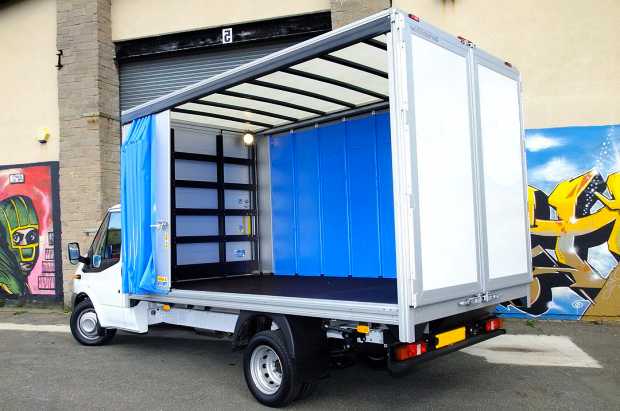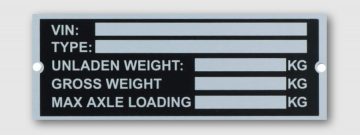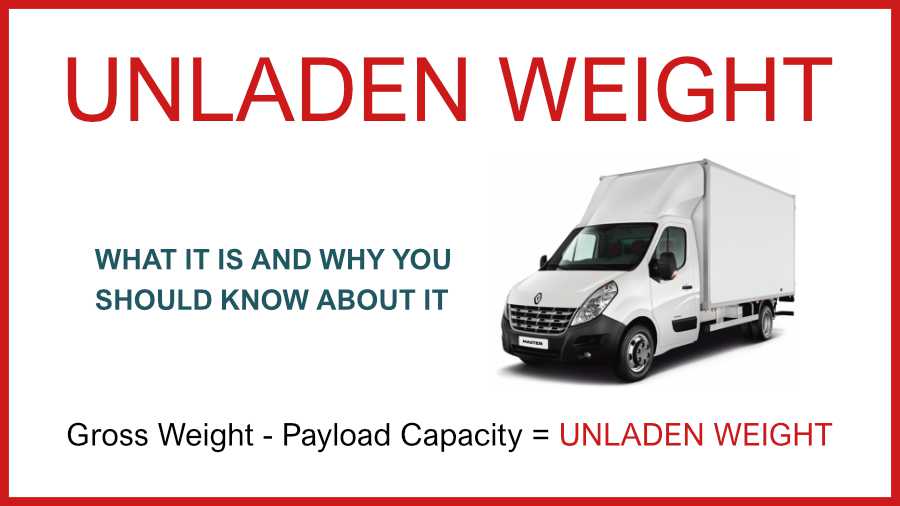The unladen weight of a vehicle refers to the total mass of any motor vehicle when it is not loaded with goods, passengers, fuel, spare wheel, or battery. It is also referred to as empty weight, or dry weight, and applies also to trailers.
The Difference Between Unladen Weight And Gross Vehicle Weight
The difference between unladen (ULW) weight and gross vehicle weight (GVW) is load weight (payload). Loading a car, van, minibus, or trailer, with any goods or passengers is considered “load weight”. The maximum permissible load weight varies from vehicle to vehicle.
For instance, if the unladen (empty) weight of a van is 1,250kg and the gross vehicle weight is 2,250kg then the maximum permissible payload of that van is 1,000kg. It’s quite simply the difference between the two.
Empty weight (1,250kg) + payload (1,000kg) = gross vehicle weight (2,250kg).

Gross vehicle weight is the maximum weight a vehicle is designed to carry overall. It should never exceed empty weight + payload.
Mass Not Attributed To Unladen (empty) Weight
Your vehicle is used to carry or transport goods, passengers, and other items that are not included in the overall unladen (empty) weight which includes:
- Fuel
- Battery & battery modules *
- Passengers
- Spare wheel and tool kit
- Goods or items that are not part of the vehicle’s own weight
* The battery is counted as part of the unladen weight only if the vehicle is a mobility scooter or an electric wheelchair. In all other cases such as petrol, diesel, or electric vans or cars, batteries and battery modules are counted as part of the available load weight.
Lowering A Vehicles Dry Weight To Raise Payload
You can lower the dry weight of a van, or any other type of vehicle, by simply removing any parts or components that are not critical to the normal function of the vehicle itself and which don’t compromise the safety of the vehicle. These include components such as the following…
- Electric window motors
- Air conditioning units
- Sound deadening
- Spare seats
- Carpeting
- Sound system
- GPS
It should be noted that although this is a valid option to lower the empty weight of your car or van, it is only really practical for those who race stock cars or attend track days.
If you’re a van driver looking to increase payload without exceeding GVW (gross vehicle weight), for instance, the amount of extra payload you would gain from removing the non-critical components of your van is negligible at best. Buying a van with larger dimensions that is capable of carrying a heavier payload would make much more sense.
The Unladen (empty) Weight Of A Luton Van
Below is the unladen (dry) weight of the most common Luton Box vans on UK roads.
| MAKE/MODEL | BODY TYPE | UNLADEN WEIGHT | MAX PAYLOAD | GVW |
| Citroen Relay | Luton Van | 2,420kg | 1,080kg | 3,500kg |
| Ford Transit | Luton Van | 2,484kg | 1,016kg | 3,500kg |
| Iveco Daily | Luton Van | 2,380kg | 1,120kg | 3,500kg |
| LDV V80 | Luton Van | 2,375kg | 1,125kg | 3,500kg |
| Mercedes Sprinter | Luton Van | 2,500kg | 1.000kg | 3,500kg |
| Nissan NV400 | Luton Van | 2,288kg | 1.212kg | 3,500kg |
| Renault Master | Luton Van | 2,288kg | 1.212kg | 3,500kg |
| Vauxhall Movano | Luton Van | 2,288kg | 1.212kg | 3,500kg |
| Volkswagen Crafter | Luton Van | 2,500kg | 1.000kg | 3,500kg |
* It is worth noting that the maximum plated payload of a van, or any other vehicle, isn’t how much in kg you can legally carry. You should take into account the weight of fuel, spare wheel, and battery, which is not included in your vehicle’s empty weight which, in turn, will lower your available payload.
Dry/Empty Weight And The Risk Of Overloading
Dry weight, payload, and GVW, along with many other types of weird weight classifications, apply to all road-going vehicles. That said, I’ve yet to see a car or an MPV on a weighbridge.

Weight types and different vehicle classifications are actively minded more by van, truck, lorry, and passenger-carrying vehicle operators where weight regulations are heavily enforced by the DVSA. These vehicle classes are used primarily for the transport of goods or people and regularly exceed the legal payload limit. Albeit inadvertently.
For anyone interested enough, the DVSA offers a handy PDF guide on how to avoid overloading your vehicle. The guide is written with an HGV operator in mind but is applicable to any other commercial vehicle type.
The Difference Between Unladen Weight & Kerb Weight
It’s easy to confuse unladen (dry) weight with kerb weight, they’re similar but they’re not the same.
With dry weight being the mass of the vehicle on its own minus fuel, battery, spare wheel, goods, and passengers, kerb weight is the mass of the vehicle minus only goods and passengers.
When referring to a vehicle’s kerb weight, a battery, spare wheel & tool kit, a 90% full tank of fuel, and standard equipment are included in the overall mass.
That said, this is in complete contrast to what Ford has to say on the matter who believes unladen & kerb weight is in fact one and the same.
Kerb Mass:
“Unladen weight (i.e. not carrying a load) of the vehicle, with fluids, 90% fuel, standard and any optional equipment, but excludes load/cargo weight and weight of the driver.”
From the Ask Ford UK website
To read the full article, click here.
In A Nutshell
Cars, vans, and trucks do get older and will pass between successive owners throughout their working life. During this time, aftermarket components and other parts will be fitted, removed, or replaced, so the plated weight of your vehicle might not be as accurate as you would assume.
The only sure-fire way of determining how heavy your vehicle is, unladen and to the ounce, is to visit a local weighbridge. A quick Google search should turn up a local company in your area that offers this type of service.
